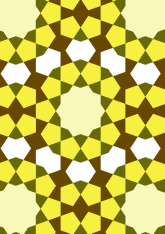Hunat Hatun Complex
 data186/HH2
(Click on image for high-quality PDF version)
data186/HH2
(Click on image for high-quality PDF version)
Geometry
- The symmetry group of the tiling is 2*22 (cmm).
- All the internal angles of the constituent polygons are a multiple of 36°.
- Contains 7 regular pentagons.
- Contains one regular 10-pointed star polygon with vertex angle of 108°.
- There are three non-regular reflective tiles (including one kite).
- The tiling satisfies the interlace condition and has three finite interlaces and one infinite interlace with straight cross-overs.
- The tiling is edge-to-edge.
- As drawn, contains about 223 polygons.
References
Publications referenced:
- Figure 482 (Hunat Hatun Complex, Kayseri, Turkey) of Derek Hill. Islamic architecture and its decoration, A.D. 800-1500..., Faber and Faber, Pressmark 35.C.183, 1964. ISBN 050051032. [hill] {With an introductory text by Oleg Grabar}(13th century AD)
- Fig 11.10a of Brian Wichmann and David Wade. Islamic Design: a Mathematical Approach, Springer, 2017. ISBN 978-3-319-69. [ww] {}
- Page 88 (Sheikh Lotfollah mosque, Isfahan, Iran. From an interior door) of Javad Shafai. On decoration in Persian architecture and wood carving, Tehran, 1977. [shafai] {In Persian}
Collections of similar tilings
Patterns using same irregular tiles: 25
v54

